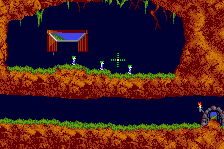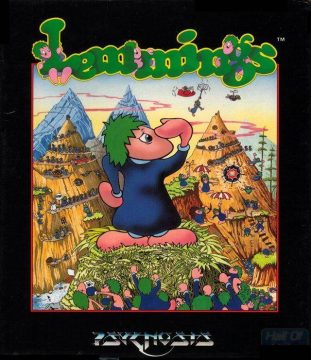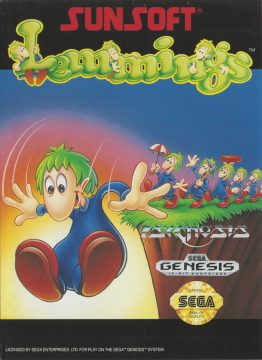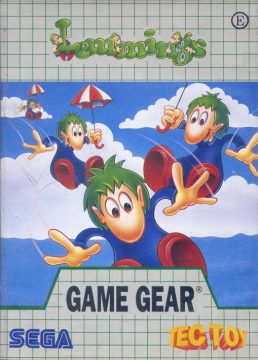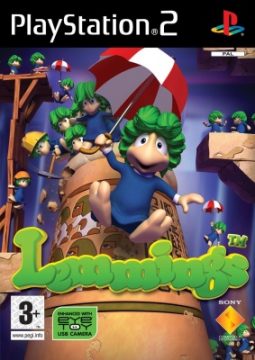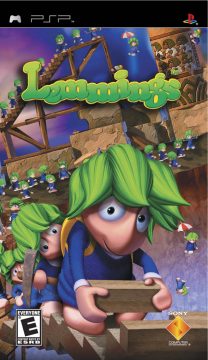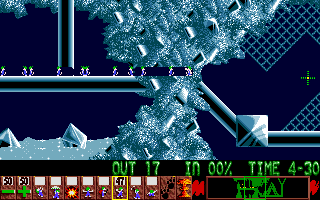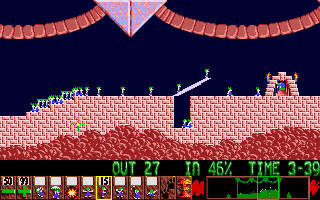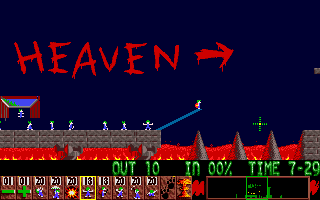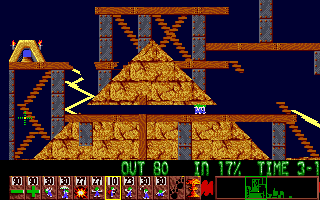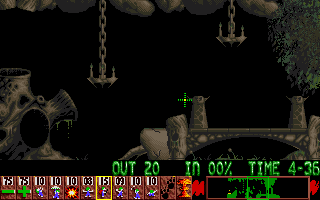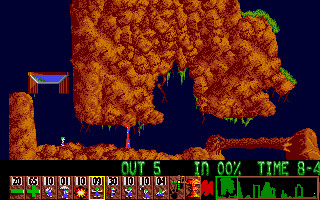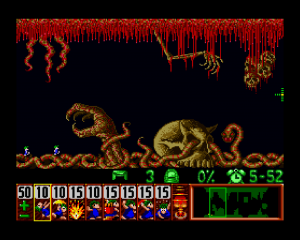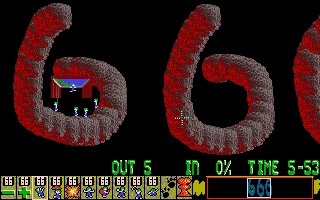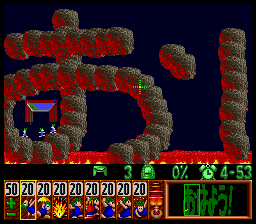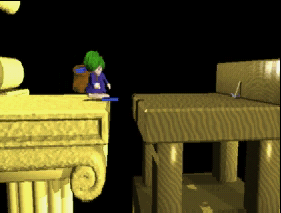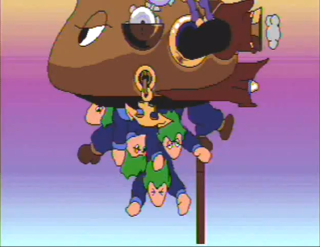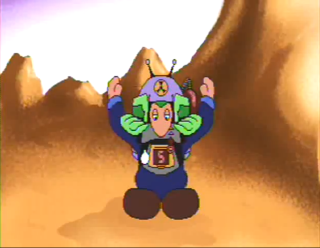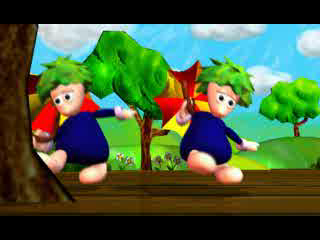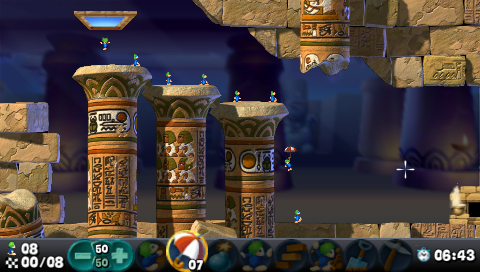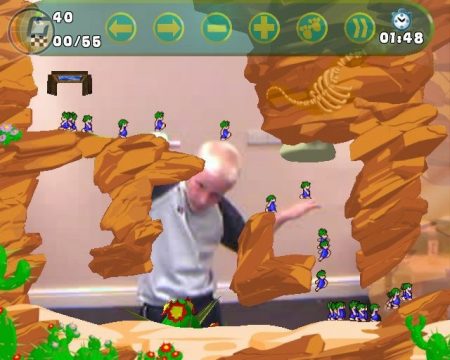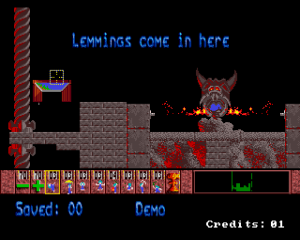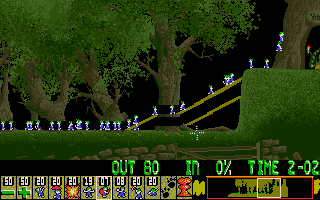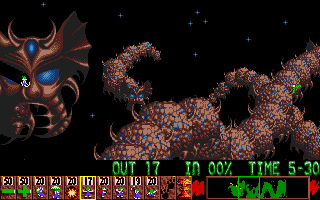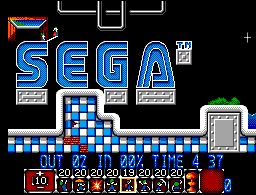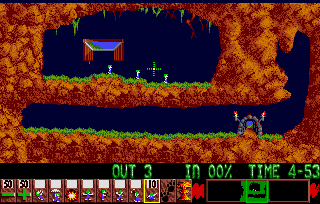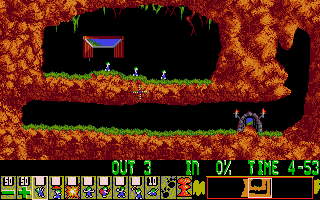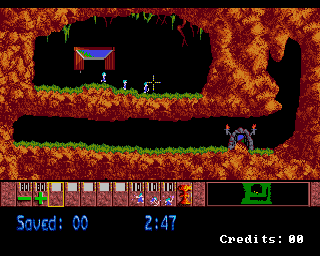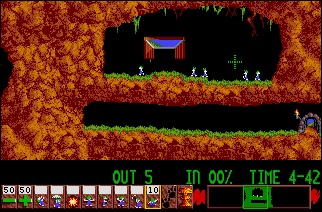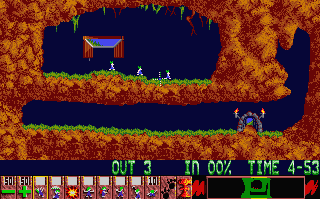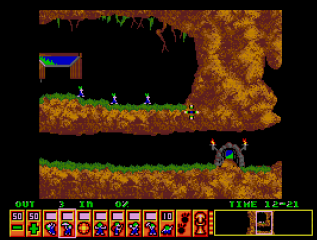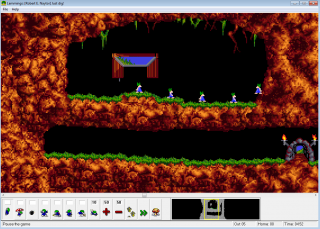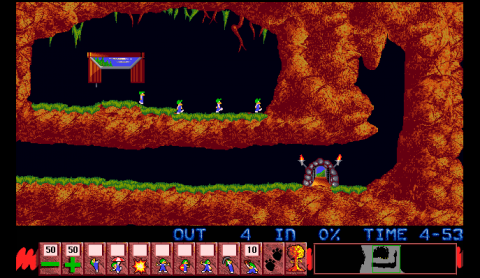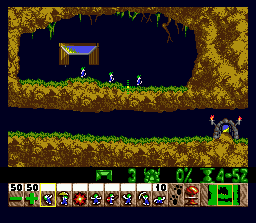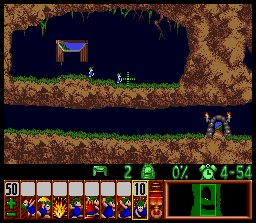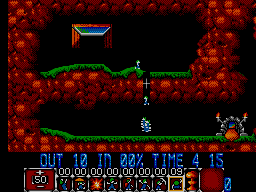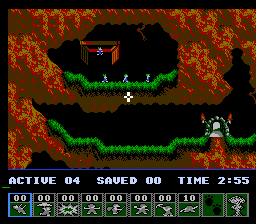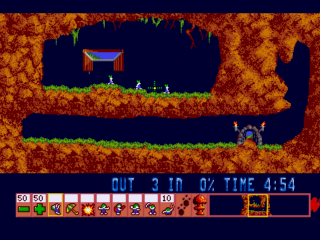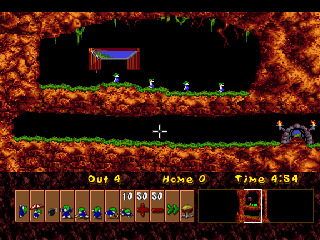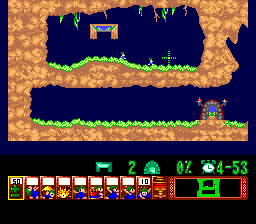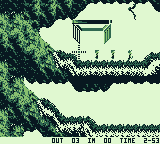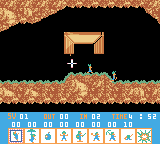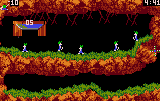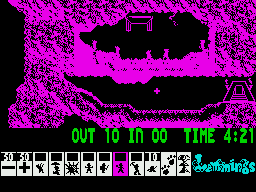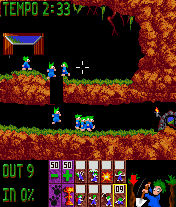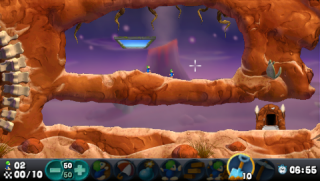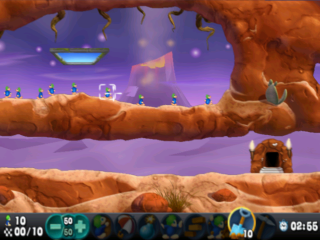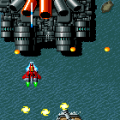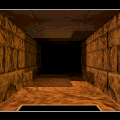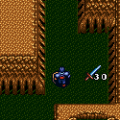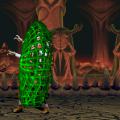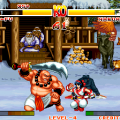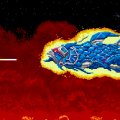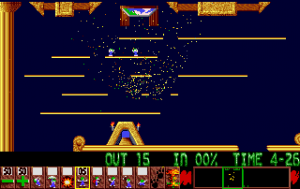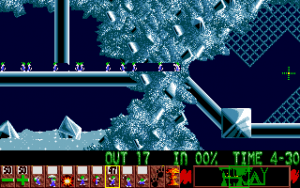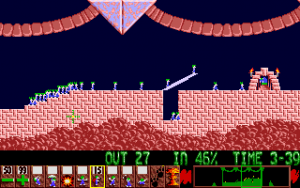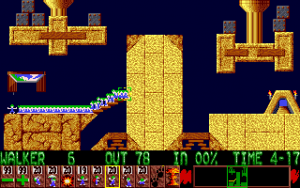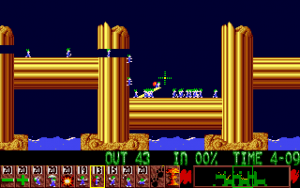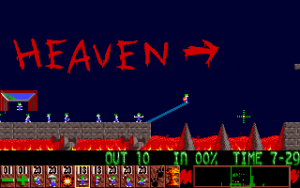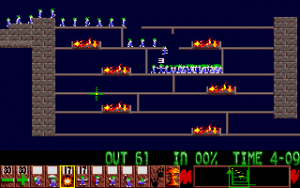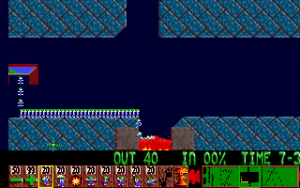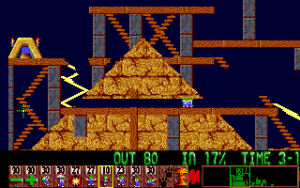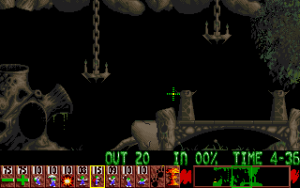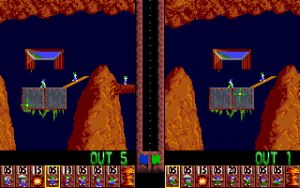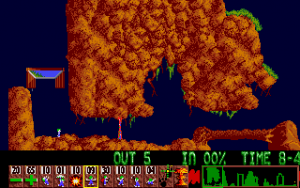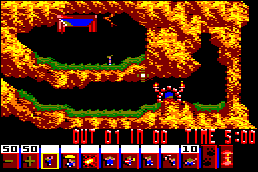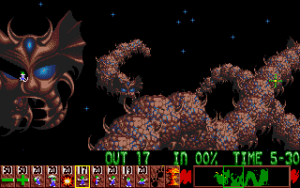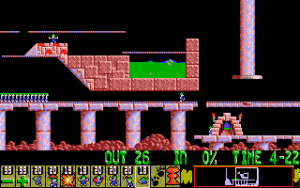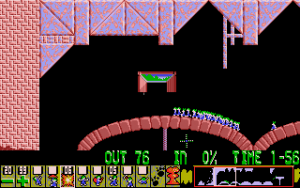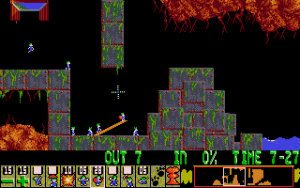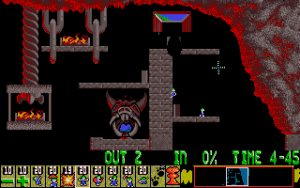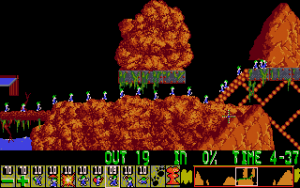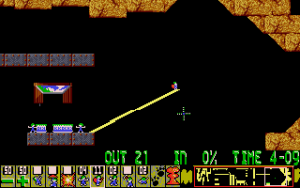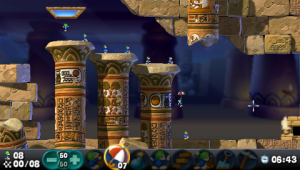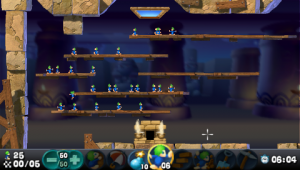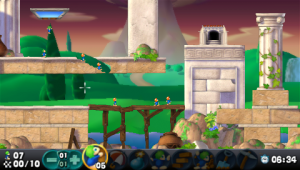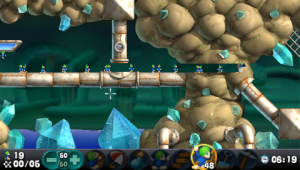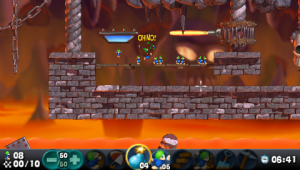As cliché as it sounds, Rockstar is a company that truly needs no introduction. It’s indisputable that their games, including the Grand Theft Auto series they’re most known for, are wildly popular, along with the new franchises they’ve founded. Of course, they didn’t always start off like that. Rockstar started off as a small Scottish game developer known as DMA Design, making reasonably popular Amiga games like Menace and Blood Money. The whole idea for the franchise started out with one of DMA Design’s artists, Mike Dailly, creating a small character sprite for one of their future games, Walker. The team agreed that a game involving the little humans would be a good idea, and the concept eventually became Lemmings.
The game was wildly popular when it was released, earning several awards, getting ported to nearly every system of the time, and getting ripped off dozens of times with games of varying quality. The earlier games in the series were published by Psygnosis, until they were bought out by Sony and became Sony Liverpool.
The series itself is, for the most part, a combination between a puzzle game and an action game. The lemmings are a bunch of cute, green-haired creatures which will walk blindly ahead at all times. If they hit a wall, they’ll turn around, and if they reach an edge, they’ll just walk right off of it, no matter what’s under it, as you’d expect from the name. You don’t directly control the lemmings; instead, you assign certain abilities to them with a crosshair to help them reach the exit.
This is the same basic formula all the games follow, although the gameplay’s tweaked around a bit in each game. While there have been a few spin-offs in terms of gameplay and different genres entirely, for the most part, each game is the same concept, tweaked around a bit with new ideas added in.
Holy damn, that is a lot of ports. The only game anywhere close to possibly overtaking that number is something like Pac-Man or Tetris.
The concept is straightforward. The lemmings are trying to go somewhere that’s not really explained what it is, and it’s your job to guide them there. Some versions come with a cute introductory cutscene of the beings mindlessly wandering forward, but this doesn’t really explain anything, either.
The game is split into 120 levels with four difficulties: “Fun,” “Tricky,” “Taxing” and “Mayhem.” You’re free to start from the first level of each difficulty, but to continue on anywhere after that point, you’ll either need to actually make your way there or use a password. In each level, your goal is to take the group of lemmings you’re given, which can go from 10 to 100 depending on the level, and get them to the exit. Succeed in meeting your quota and you go onto the next stage. Fail and you’ll have to reset the level. Thankfully, the game gives you infinite tries, which is really useful considering how frustrating some of the puzzles can get.
What’s stopping your lemmings from getting to the goal are solid walls, that will make your lemmings turn around and walk the other way, pits, which lemmings love to walk into, and long falls, which kill them instantly. Some levels also have traps, some of which are obvious, like huge pools of lava, spinning blades, and flamethrowers. Others are more insidious, like the retractable boulder, which will crush your lemmings and pull them apart in a red, gooey mess if they walk under it. Somehow, this surprisingly gory animation made it into the Super Nintendo version uncut, which is weird considering Nintendo’s stance at the time on games like Mortal Kombat.
Your lemmings aren’t entirely defenseless against these hazards, and each level gives you a set number of abilities that you can assign to a lemming by clicking on him. Some abilities will remain active for as long as a lemming is still in the level, and others will only last until the lemming is finished with his action. Clearing each level is all about knowing the right ability to use at the right time, and since the game runs in real-time, you will need quick reflexes from time to time to save your lemmings.
The “digger” power causes a lemming to dig straight down through the ground, while the “miner” power makes them slowly dig diagonally down in the direction they’re currently facing. The “basher” power makes lemmings dig horizontally through the ground. “Blockers” stand still and make any lemmings that touch them stand still, which is useful for blocking off a cliff so none of the lemmings fall off it. Since blockers can’t move at all once they’re set, unless the ground under them is removed, this is a good time to use the “bomber” power on them, which causes the lemming it’s used on to explode after a five second countdown.
Builders place twelve small steps diagonally upwards, which other lemmings can use to reach high places and cross pits. The “floater” and “climber” powers are mostly permanent and last until the lemming they’re used on dies, becomes a blocker, or reaches the goal. The climber power lets lemmings scale vertical surfaces, while the floater power gives a lemming an umbrella to fall long distances without dying.
The challenge is that you only get a limited use of abilities per level, and some levels may not give you a certain power type at all. You also have to keep in mind alternate solutions as you play. For example, you may have enough floater powers to get some of your lemmings to the goal, but you might have to find another way to get your lemmings down once you run out of that. It’s entirely possible to screw up by running out of a certain power too soon, or by having too many lemmings die to meet your quota, or simply by running out of time. Not all versions of Lemmings give you an option to just restart the level. Instead, you get what the game calls the “Armageddon” button. Once you use this, every lemming on screen turns into a bomber, causing them all to explode into little bits. Cruel? A little. Hilarious? Oh yes.
The levels start off fairly easy, and the first half of the “Fun” difficulty basically serves as a tutorial on all the powers and how to use them. The game does get harder as you go along, with the levels getting longer and introducing new hazards to deal with. Eventually, you’ll start coming across levels with two entrances the lemmings come from, having you deal with lemmings on separate sides of the map entirely. However, there are quite a few times when the game gets lazy and repeats a level, only changing it by making you save more lemmings or giving you fewer powers to use. The toughest levels even require you to exploit some of the game’s quirks, like having builders make so many stairs that lemmings can’t climb the base of them, in substitute of a blocker.
There are a few flaws with the game’s design that can get pretty annoying. One of them is the fact that there are a lot more reflexes required than in most puzzle games. Even when you think you’ve found the perfect solution, there’s still ways to mess up completely, like a bomber who clears away so much ground that there’s nowhere left for your lemmings to walk. Some require precise timing or positioning, like determing when use the bomber skill so the lemming detonates at the right spot, or know when to start building so the stairs are properly positioned. Just a few pixels off, and you can mess everyting up. You can pause the game to get your bearings and scroll around the level, but you can’t assign abilities to lemmings while the game is paused.
The lemmings are also pretty slow, and on the longer levels, getting all of them into position can take a while, though only a few of the ports have a fast forward feature. There are going to be a lot of times when you have to sit and wait, possibly for a whole minute or two, for a lemming to reach a specific spot so you can give him another action. This is especially annoying when it turns out your plan that you waited so long to enact didn’t even work out.
There’s also the fact that with it’s easy to lose track of the lemmings once they start to bunch together, leaving one hundred lemmings as nothing more than a big green, white and blue blob. This can be a real pain when you’re trying to select a specific lemming facing a specific direction, and you can’t even see him. There are times when you can use blockers to slow the flow of lemmings to make things more manageable, but doing this does waste away your blocker and bomber stock. This is, however, a element to many of the stages, where you need to figure out how to corral most of the lemmings, while sending one forward to pave the way for the rest.
Aside from the 120 single-player levels, some versions of the game come with a two-player option with twenty unique levels. The Amiga could actually support two mice at once so that two players could play on the same computer. Unfortunately, since many computers couldn’t do that, this option was mostly reserved for the console ports. In this mode, Player 1 controls blue lemmings, while Player 2 controls green lemmings. Each player has to bring lemmings to their own goal, or use some of their own to sabotage the other player’s efforts.
The graphics are good for a puzzle game, but haven’t aged entirely well. The lemmings animate pretty smoothly for being an 8×8 sprite, and there are a few cute details if you pay attention, like the way Builders will shrug and continue walking when they run out of stair pieces. There are several different level themes, like temples, underground areas, and Hell (!), but the background is always a stark black or blue, no matter what. That’s forgivable, though, since a fancy background would probably make picking out the lemmings even tougher.
The sound’s pretty decent, and the lemmings get a few voice clips of their own. There’s a cheerful, “Let’s go!” when you begin a level, and an “Oh no!” when they inevitably get blown to bits. The game uses a lot of public domain music, like the “Can-Can Dance” and “She’ll Be Coming ‘Round the Mountain.” The songs are decent, but the choices in instrumentation make them a little annoying to listen to.
The original Amiga version of the game and some of the computer ports have “crossover” levels, which are levels that use graphics and music from Psygnosis’ other games, like Shadow of the Beast and Awesome. One of these levels is called “Menacing”, which is a hellish landscape where rotten body parts dangle from a ceiling made entirely of veins, while the lemmings walk across a landscape of snakes slithering through a human skull. This somehow made it into the Super Nintendo version of the game as well.
However, the most controversial level is Tricky stage 21, known as “All the 6’s…”. The level is shaped like the numbers 666, and all of the goals and number of lemmings are based off the number 6. It also uses the Hell theme, of course. This rankled some feathers due to the relationship of these numbers to the evil, so it was taken out or changed in later releases. The SNES version, for example, changes the name of the level to “Ohayo Lemming-san”, and changes the level to spell “ohayou” in hiragana (“Good morning”). The Genesis version replaces it with a completely different level. Some other versions chop it out entirely.
Overall, Lemmings is a fun and fairly addictive puzzle game with a unique concept. It has a few design flaws that really should have been looked into, as well as a really shaky difficulty curve, but if you’re into puzzle games, it’s definitely worth playing. Ordinarily, this would be the point where we move onto the sequel, but this game had so many damn ports to so many consoles that it’s almost worth its own article alone. There’s probably a microwave out there somewhere that could play Lemmings.
While Lemmings originated on the Amiga, most of the computer ports, like the Atari ST, Acorn Archimedes and FM Towns are identical, except for slightly different sounding music. The console versions, while varying in quality, all suffer from the fact that the directional pad just isn’t as accurate as a mouse. Many of the ports are also missing the “crossover” levels for one reason or another, with them being replaced or removed entirely. Also, only a few ports, such as the console ones, actually keep the two-player feature.
The DOS version is probably the most played version these days, as well as the most modded. It’s fairly decent, but it’s missing a few things, such as digitized speech. The Adlib TRIES to make a “Let’s go!”-esque sound, but it doesn’t really work. Graphically it’s almost identical, though the backgrounds are black rather than dark blue, and it’s missing a two player option, since IBM PCs typically did not support two mice. Still, there’s nothing especially wrong with it besides those few omissions. There are CD versions that are packed together with Oh No! More Lemmings, which include some decent CD audio remixes.
The Windows 95 port is probably one of the most playable ports of the game, next to some of the console versions. It uses the Windows interface, meaning there are scroll bars to scroll the level, drop-down menus, and you can drag and drop pieces of the interface to suit you. There’s also a high-resolution mode, which zooms the screen in, using bigger, redrawn sprites for the lemmings. This is pretty nice, both graphically and gameplay wise, since the lemmings are now a bit more distinct. The game also has a fast-forward feature, although on newer computers this will basically end the level instantly. Unlike most versions which use passwords to keep your progress, this version actually saves your game after each level, letting you choose from any of your unlocked levels to play. The redbook audio soundtrack is identical to the DOS CD version. The game also comes with both the original levels and the levels from the expansion pack, Oh No! More Lemmings.
The Macintosh version comes with the original levels and the Oh No! More Lemmings levels. It uses bigger sprites, like the hi-res mode of the Windows port. Unfortunately, it runs in a window-boxed fullscreen mode, and the music, played through QuickTime, sounds pretty bad.
In the NES version, the lemmings seem to move a bit faster than most of the other ports. It’s a decent port, but there’s one weird issue where you can ONLY have music or sound effects while playing the game, never both. The game is also missing about 20 levels, five for each difficulty, and only 14 lemmings can be on screen at the same time.
The Game Boy version seems mostly based on the NES version, although you get both music and sound effects. The major issue is that the whole game is very slow, which makes the longer levels even more of a pain. The fact that the lemmings are monochrome doesn’t make it any easier to pick them out, especially on a small screen. There’s also a control issue where lemmings won’t do actions you assign to them right away, which can really mess with your timing on some levels.
The Game Boy Color version, released way after the deluge of ports, is pretty crappy, sadly. You get both the original levels and the Oh No! More Lemmings levels, but the game still seems to run in slow motion, although not quite as badly as the Game Boy version. There’s also a new soundtrack that isn’t nearly as good, and the first level plays this really menacing tune that doesn’t fit with the game at all. On the other hand, it does battery save your game after every level, which is nice.
The Super Nintendo port by Sunsoft is probably one of the best console ports. It’s also one of the most untouched ports, entirely leaving in the crossover levels, their graphics and music included, outside of changing Tricky 21, anyway. It plays pretty well, barring the issue of controlling the game with the D-Pad. There are also five new Sunsoft levels, which are extra difficult. Oddly enough, with how much they’ve kept from the original Amiga version, they’ve changed all mentions of “Heaven” to “Paradise”. The soundtrack, while it uses the same songs as the original game, sounds a lot different from the other versions.
The PC Engine CD version was only released in Japan, and suffers from some very, very washed out graphics, making it easily the ugliest of the 16-bit console ports. It does partially make up for it with its excellent redbook audio soundtrack, which is entirely different from the one used in the American / European computer ports.
The Master System version is a pretty good port, and is definitely a lot more fun to play than the NES version. They even managed to fit in the digitized speech. There are a few levels missing, but in their place are five new SEGA levels which involve the lemmings running around a bathroom-like environment, with the SEGA logo prominently displayed. The Game Gear version is mostly the same, although due to the smaller screen size, the ability bar doesn’t show up until you scroll the cursor to the bottom of the screen. Both ports have music done by Matt Furniss, who went on to do some amazing work for the Genesis.
The Genesis version developed by Sunsoft is also worth playing. It plays mostly similar to the Super Nintendo version, and includes the Psygnosis-themed levels. Some of the other original levels were replaced entirely with new ones, and there are also 60 new levels plus two new difficulties, “Present” and “Sunsoft.” It’s worth playing this version just for the number of new puzzles alone, a lot of which are really tough. The redone music makes excellent use of the Genesis FM chip. Unfortunately, even though there is a mouse peripheral for the Genesis, the game won’t actually let you use it since it was released after Lemmings was published, so you’re stuck with the D-Pad.
The Lynx version is one of the worst handheld ports, possibly even worse than the one for the original Game Boy. While it is in full color, the screen is so zoomed in it’s hard to keep track of anything. Instead of having a bar at the bottom of the screen that shows all of your abilities, you have to hit a button to bring up a separate screen, slowly scroll over the power you want, select it, and then return to the game. While the gameplay does pause on this screen, it makes timing your moves a lot more of a hassle than it should be.
The 3DO version is pretty much the same as the IBM PC CD version, even using the same soundtrack. It includes a very, very bad FMV intro using rendered graphics, showing off the different skills of the Lemmings. The Phillips CD-i version looks alright at first glance, and again, uses the same CD audio soundtrack, but the frame rate is incredibly, incredibly slow and choppy, making it quite pitiful. It also has an animated intro, though this one is more of a short cel-animated cartoon. The animation is somewhat cheap, and the whole thing has a style reminiscent of the Zelda CD-i games (though not quite as bad), but it is rather humorous, as the Lemmings use their various skills to deal with a variety of other animals.
The PlayStation version also has an FMV intro, but it’s entirely different from the 3DO and CD-i versions, showing off the lemmings doing the Can-Can, but otherwise looks identical in graphics to pretty much every other version. The music is similar to the other computer CD versions, though not quite the same. You’d think they could have added in background art or something, since a game like this, released in 2000, is a bit plain. The game does come with the original levels and Oh No! More Lemmings levels, along with a feature to save your game to the memory card, but for the PlayStation, you’d expect more.
The PSP version was released in 2006, a staggering 15 years after the original game, by the Worms developer Team 17. It’s surprising that we never ended up with some kind of Lemmings / Worms crossover, due to the striking similarities in art style and characters. (Incidentally, Worms originally started as a Lemmings fan game according to this NeoGAF post.) The PSP version is basically a remake of the original game, along with 36 brand new levels. Everything’s been updated to make the game easier to play, including fast-forward and zoom features.
A pretty big change in gameplay is where you can now assign powers to lemmings while the game is paused, which may feel like cheating to some people. The graphics are much improved, having been redone entirely with prerendered landscapes, and now there are actual backgrounds for each of the five different level sets. The music has been entirely redone, being the last work by famed composer Tim Follin. A few remixed versions of old songs remain, but the rest is completely unlike any of the other Lemmings games. It’s quite good, though a bit laid back and less melodic, so it’s not quite as immediately catchy. The song “Hell 3” is actually an arrangement of the Ghosts n’ Goblins theme song for the Commodore 64, which was an original song for that version composed by Follin. The game also comes with a level editor to design and share your own levels, which is a pretty nice feature.
The PS2 version, only released in Europe, is a port of the PSP version. Therefore it’s mostly the same, though the graphics are a bit blurry. There’s also a new mode that makes use of the Eye Toy. In this mode, you’re supposed to use your body to make paths for the lemmings to traverse, but with how finicky the Eye Toy is, this doesn’t actually work too well in practice.
There is another version of Lemmings on the PlayStation 3, released in 2007, but it is actually a whole new game and not a remake, so it will be discussed in a later section.
The arcade prototype of Lemmings by Data East is just plain weird. It was never officially released, and the only prototype available for emulation is a little unpolished. The game starts with a small tutorial that shows you the basics, and then takes you to a level list of 56 levels to pick from. You can actually start from any level you want, which is weird compared to most versions. The level order has been changed around a lot, and a few of the levels are brand new.
The major difference in gameplay is that you’re always under a strict time limit. The clock runs down faster than the other versions, and it doesn’t reset once you clear a stage, although you do get bonus time for beating a level once per credit. If you run out of time, instead of failing the level, the game pauses and gives you 15 seconds to insert another credit for extra time. Since a lot of the levels take a while to beat, you WILL have to put in a few credits to get anywhere. There’s also a ?ehurry’ button, which switches between fast-forwarding the game up and pausing it, plus you can assign abilities to lemmings while the game’s paused. This might feel like cheating to some people, but it’s still handy.
The game also gives you small hints on where to use certain powers, along with a high-pitched lemming voice that offers hints and gives commentary. The hints are a bit buggy and sometimes the game will tell you to nuke your lemmings for no real reason. If you actually do this, the game will tell you that you “really need help,” and that you’re supposed to save the lemmings, which is pretty chuckle worthy. Overall, it’s worth playing as a curiosity, but if this version was actually released, the fact that it drains so many quarters from you so quickly, along with the fact that Lemmings is just too slow-paced to be a good arcade game, probably would have made it pretty unpopular.
The series would continue on, although the later games in the series wouldn’t get nearly as many ports as the first game did. It proved to be a major hit with European gamers, and did fairly well on American shores as well.
